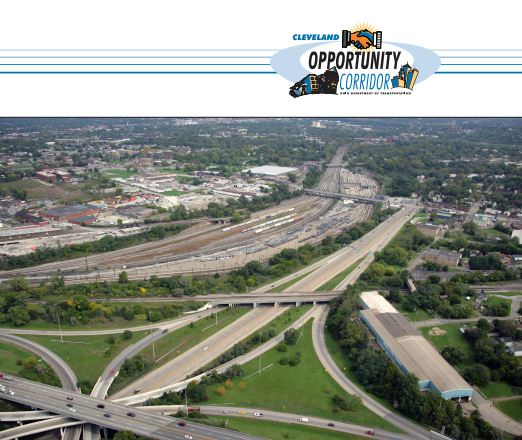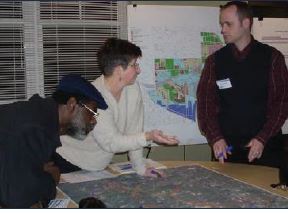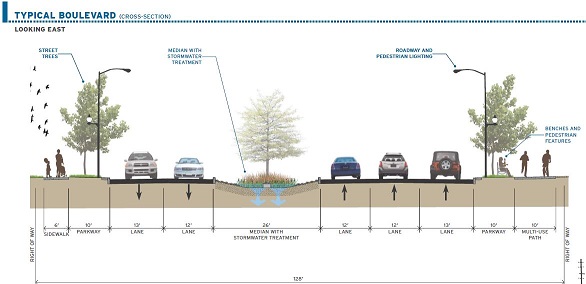The Ohio Department of Transportation is using public engagement methods to identify ways to reduce potential impacts on low-income and minority residents from a new 3.5-mile urban boulevard project in Cleveland.

The environmental justice efforts related to the “Cleveland Opportunity Corridor” project have been well received by residents and have resulted in several strategies approved by the impacted neighborhoods.
The project, which is expected to support the revival and redevelopment of an underserved area of Cleveland, required mitigation to address potential adverse impacts on the high percentage of low income and minority populations living and working within the project area. The project is jointly managed by the Ohio Department of Transportation, the City of Cleveland, Greater Cleveland Partnership, and the Opportunity Corridor Partnership Office.
Public Engagement
ODOT begin public engagement in 2009 to obtain input from the affected neighborhoods. ODOT and the city provided information and solicited feedback using fliers posted at churches, community centers, and recreational facilities; verbal and written surveys and questionnaires; map and design exercises; one-on-one meetings; announcements through email, media advisories, direct mail, newspaper advertisements, and press releases; and interviews with residents and local businesses.
Over time, the project team adapted to the needs of the community. For example, reader-friendly newsletters and large-size font size on printed material were created, U.S. Postal Service data were used to reach more people including both property owners and tenants, and postage stamps were made available at meetings to facilitate the mailing of comments.
In-person meetings were designed to encourage participation. Meetings were held both in the evening and during the day to address concerns about safety and to be available to older adults and small business owners. Meetings were held in neutral locations within each neighborhood, and meeting sites were located as close as possible to residents and businesses.

ODOT also allowed attendees to rank and indicate their level of support for various functional elements and amenities, such as wayfinding signage, ornamental lighting, and dedicated bike lanes and streetscape elements.
The flexibility and diversity of public involvement methods allowed the project team to identify what the community felt was important and what types of mitigation measures would be the most beneficial. These methods also allowed ODOT to reach more people in the communities and, therefore, more people were able to participate and provide their input.
Mitigation Measures
Based on these outreach efforts and the project team’s environmental justice impact analysis, ODOT and the City of Cleveland committed to various measures to mitigate potential impacts of the highway project.
One measure is the construction of two pedestrian and bike bridges. The neighborhoods in the project area abut segments of track used by freight railroad and rail transit. As part of the project, ODOT will create a bridge near the southern end of the project near the I-490/E 55th street interchange to provide access over the new boulevard for residents in the nearby neighborhood. The bridge will grant access to the Greater Cleveland Regional Transit Authority transit station just north of the boulevard.
A second bridge for pedestrians and cyclists will replace the existing vehicle bridge on East 89th Street that is scheduled for removal. This will maintain connection between neighborhoods north and south of the railroad tracks.
Additionally, ODOT is contributing $500,000 toward the planned expansion of the Kenneth L. Johnson Recreation Center, a city-owned park and fitness center that is an important community facility community. As another commitment, ODOT is providing at least $500,000 toward diversity hiring, using small and disadvantaged businesses as contractors, and providing job training and employment for people living in the vicinity of the project
Other mitigation measures include relocation assistance for required and voluntary residential relocations, the installation of noise walls, and enhancements throughout the neighborhoods, such as improved streetscapes, enhanced bus shelters, and more street lighting.

Context-specific public engagement activities assisted the project team in identifying mitigation measures that would best meet the needs of the community. Some of these measures included providing job training and voluntary housing relocation, which are not common mitigation measures for ODOT. Others included improving pedestrian access and safety, which occur much more frequently. Since the public had the opportunity to provide their input and explain what was most important to them at multiple points during project development, ODOT was able to design the project to have lasting benefits.
Challenges and Lessons Learned
The project team knew early in project development that the Opportunity Corridor’s complexity and location would require special consideration. While the goal of the project was to improve quality of life by providing better links and mobility and supporting economic development, there also would be negative impacts.
Working closely with community leaders and engaging a national environmental justice expert helped ensure that ODOT was incorporating the concerns of the community into project planning. The agency learned the importance of working very closely with the communities and being flexible with plans to engage the public. It is important to have the ability to change and adapt both public involvement activities and the project itself to meet the public’s needs.

The project was scheduled to be completed in three phases. Sections one and two have been opened to traffic as of November 2018. Section three, which includes both of the new pedestrian and bicycle bridges, is scheduled for completion by the fall of 2021.
For more information about the Opportunity Corridor, see the project website or contact Erica Schneider, ODOT Assistant Environmental Administrator, at [email protected].